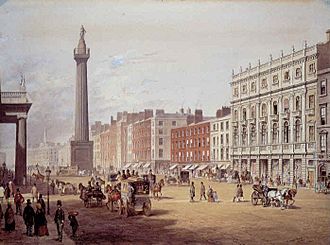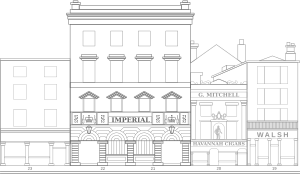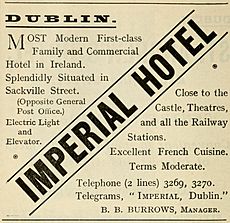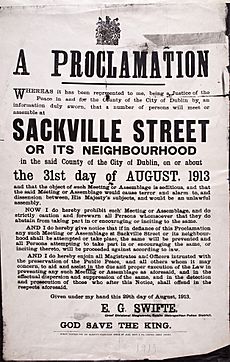Imperial Hotel, Dublin facts for kids
Quick facts for kids Imperial Hotel |
|
|---|---|

1853 view of Sackville Street, the hotel William Caldbeck rebuild shows just eight windows and no identifying signage
|
|
| General information | |
| Status | Destroyed |
| Type | Mixed hotel and business |
| Location | Sackville Street |
| Town or city | Dublin |
| Country | Ireland |
| Coordinates | 53°20′57″N 6°15′34″W / 53.34912°N 6.25956°W |
| Opened | May 1837 |
| Renovated |
|
| Destroyed | April 27, 1916 |
| Client | Clerys Department Store |
| Owner | Mcswiney, Delany and Co. |
| Renovating team | |
| Architect |
|
| Main contractor | Fagan & Son |
The Imperial Hotel was a well-known hotel in Dublin, Ireland. It was located on Sackville Street, a main road in the city. The hotel was destroyed during the Easter Rising in 1916. The building also contained Clerys department store on its lower floors. It stood right across from the General Post Office and Nelson's Pillar.
Contents
History of the Imperial Hotel
The Imperial Hotel was on Lower Sackville Street in Dublin. A writer named William Makepeace Thackeray once called it an "exceedingly broad and handsome" street. In 1924, Dublin Corporation decided to rename the street O'Connell Street.
In 1844, a German visitor named Herr J. Venedy wrote about the hotel. He said the hotel was run in an "English manner" with mostly English staff. He recommended it for good beds, food, and cleanliness. But he also suggested that if you wanted to meet Irish people, you should stay somewhere else!
Pictures from 1850 show the hotel building had four windows facing the street. The hotel's name was used at least as early as 1843. In 1853, an architect named William Francis Caldbeck rebuilt it. The new building had eight windows and housed Clerys department store on the ground floor. The Imperial Hotel was on the three floors above. Its address became 21–27 Sackville Street. The department store had very tall, large windows. In 1863, James H Coleman was the hotel's manager.
Charles Bianconi, who was famous for his coach services, often visited the Imperial Hotel in the 1860s. His daughter wrote that he liked it because it was close to where his coaches departed. It was also near the General Post Office. Even when he used a wheelchair, he met friends there. He was known for getting a lot of business done at the hotel.
In 1875, William Martin Murphy bought the hotel and department store. He was a businessman with many other interests. Around 1902, the hotel was made even bigger. Three more sections were added, making the front eleven windows wide. This work was done by Dublin architect George Coppinger Ashlin. He also added a fancy iron canopy over the main entrance. This canopy had the hotel's name woven into it and was made by Fagan & Son. The building stayed like this until it was destroyed in 1916.
Mail Services at the Hotel
In the 1840s and 1850s, the Imperial Hotel had its own special postmark. This stamp showed that the mail had been paid for before it was sent. Back then, most mail was sent without being paid for first.
Many hotels in Dublin were starting points for mail and people traveling around Ireland. In 1849, the Imperial Hotel was one of these important places. Mail coaches left from here for cities like Belfast, Derry, Cork, Kilkenny, Waterford, and Wexford. Other coaches and cars also departed from outside the hotel. The hotel even had an office for "Northern and Southern Mail and Day Coaches." By 1852, the Enniskillen mail coach also started its journey from the hotel.
The 1913 Dublin Lockout
The 1913 Dublin lock-out was a major dispute between workers and their employers. William Martin Murphy, who owned the Imperial Hotel and Clerys, was also in charge of other businesses. He was not a fan of trade unions. He had fired many workers and did not want the Irish Transport and General Workers' Union (ITGWU) to organize his employees. This union was started by James Larkin in 1909.
On August 29, 1913, James Larkin spoke to about 10,000 people. He burned a paper that banned a meeting planned for August 31. He also said he would speak on O'Connell Street that day. Even though he was banned from public speaking, Larkin found a way into Murphy's hotel. He arrived disguised as an old gentleman with his niece. A few minutes later, he appeared at a smoke-room window and began to speak.
A Member of Parliament, Handel Booth, reported Larkin's words: "Comrades and friends, the police have forbidden a meeting to take place in O’Connell Street to-day, but I am here to speak and will remain till I am arrested."
As soon as he started speaking from the hotel balcony, he was arrested. Chaos broke out in the street below. About 300 police officers charged and attacked the crowd. Many people ran away, but many were hurt. Twenty police officers escorted Larkin from the hotel to a police station.
The Easter Rising and Destruction
During the Easter Rising in 1916, many buildings on Sackville Street were badly damaged. The Imperial Hotel and the General Post Office across the street were very badly hit. Only the front wall of the hotel was left standing.

Rebel groups took over the hotel. They also occupied the General Post Office and the Metropole Hotel nearby. On Easter Monday evening, food and bedding were brought to the GPO from the Imperial Hotel and Clerys. The Irish Citizen Army occupied the hotel. They raised the Starry Plough flag over the building during the Rising.
The flag was still flying even when the building caught fire. A brave soldier, Second Lieutenant T.A. Williams, managed to get the flag back. Photos taken on May 16, 1916, show the empty flagpole. Joe Sweeney, an Irish Volunteer in the GPO, said that on Friday, "All that remained of Clery's and the Imperial Hotel was the front wall... on the top of which... the flag of the Citizen Army still floated proudly." The restored flag is now on display at the National Museum of Ireland, Collins Barracks, in Dublin.
On Thursday evening, April 27, 1916, a shop next to the hotel and Clerys caught fire. The fire spread quickly to the hotel. This was because the shop had a lot of flammable products stored inside. The rebels in the Metropole Hotel tried to warn those in the Imperial Hotel about the danger. They used semaphore signals, but their warnings may not have been understood. The evacuation from the Imperial Hotel was very quick, especially when the large glass windows melted into the street.
Legacy of the Hotel
Clerys department store was given £77,292 to rebuild its part of the building. The reconstruction happened in 1922. However, the new design by architect Robert Atkinson did not include any hotel rooms.
As of 2021, the building is being redeveloped. It will become a mix of offices, a hotel, and shops. This new area will be called 'Clerys Quarter'. The new hotel will have 213 rooms and be named 'The Clery'. Most of its rooms will be in a building facing Earl Place. The hotel will be run by Press Up Entertainment.





